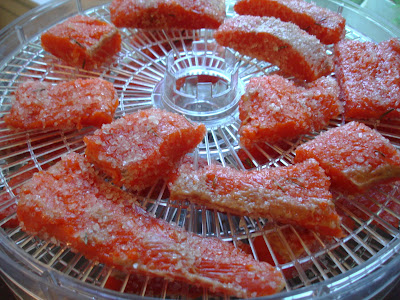Unless you're a grizzly bear (Ursus arctos horribilis) you're going to have a hard time getting your fill of wild Alaskan salmon. Especially if you live in the lower 48. That would also apply if you were one of the few hundred grizzlies who live down south. The Pacific coast salmon runs have been on the decline in the last years. They are getting dangerously low. We can dispute the causes in another post. This year, the season was cut short in much of the northwest part so as to allow (hopefully) the population to better recover. But really, the place to go for pacific salmon, the Chinook salmon, the King salmon, is Alaska. when the salmon are running from the sea back up the rivers to spawn. A process that takes 4-5 years to happen since they spend most of their life at sea.
We are not talking about the pale-pink farmed raised Atlantic salmon. No. Alaskan King salmon meat is fluorescent in comparison that pablum. Farmed-raised salmon is akin to commercially-raised tomatoes - not worth eating. And the difference between the wild and the farmed-raised fish is in the wild diet of shrimp that the salmon gorge on. It also makes a huge difference in taste, texture, and fat content of the meat. By comparison the Atlantic salmon is mealy and bland when compared to the King Salmon. Don't believe me? Try taking one away from the next grizzly bear you see? They'll set you straight.
There are only a few ways to obtain the wild Alaskan King salmon. Take a trip to Alaska and fish it out of the river. Expensive, but fun. Do a Timothy Treadwell and try taking some away from a grizzly. Fun? Maybe, but definitely dangerous. Have someone ship you some fresh salmon from the West Coast. Not as expensive, not as fun. Or, wait for the 2-3 week season during the year when you can actually buy it fresh from a fish monger in the Midwest and start gorging. Still expensive (currently about $25-30 pound) but what else are you going to do?
If you're like me and you like to stock up for the coming apocalypse (John McCain may yet be elected President so it's a definite possiblity) then one thing you can do is preserve some of that wild flavor for the times when you might want to snack in the wilderness (or the bomb shelter). Yes, you could freeze the salmon, but if you want to take it, for example on a backpacking, or river trip, then frozen isn't the best. So why not make jerky out of it?
If you go to Alaska, you'll find all sorts of great purveyors of smoked fish. Salmon, halibut. They know the deal and they know how to do it well. Great succulent stuff, but not really preserved to be kept unrefrigerated. I'm talking real portable food here. The kind that requires no refrigeration (more on that later). So then how do yo do it?
Here's how. It's really pretty simple because it's based on very simple, and very old techniques.
Wild Alaskan Salmon Jerky.
Ingredients.
3-5 pounds of very fresh, firm Alaskan Salmon.
1/2 lb honey.
Tablespoon of toasted sesame oil.
1/2 cup of grape seed oil.
3 sprigs of fresh rosemary.
Kosher salt.
Food dryer.
Wash the salmon thoroughly. Then drain.
Heat the honey, oils and fresh rosemary together. Cool to room temp.
Place the salmon into a glass or stainless dish.
Cover the salmon completely with COOLED honey and oil mixture. The fish should be completely submerged. Cover the dish and refrigerate overnight for 12-24 hours.
When you remove the salmon from the refrigerator you should notice a distinct change in the texture of the fish. The curing process has begun and curing is just another way of cooking. The flesh will have darkened and firmed.
Now drain the fish on a rack. Cut into pieces 1 inch by 3 inches. The pieces can vary but the more uniform, the more uniform the drying. You can make difference size pieces if you want. If you cut them too small, they will become brittle, rather than retain some moisture. You don't have to, or want to, pull all the moisture out. At 18 percent or below moisture content, it will be preserved.
The drying time varies considerably depending upon the dryer but typically it's going to take 12-18 hours. The fish shouldn't be so brittle as to crumble when done. It should have the texture of jerky, somewhat plastic. As it cools, it may become more brittle. The tendency is to overdue it; it's an expensive mistake. Any excess salt on the exterior can be brushed off when the drying is complete.
Now wrap the pieces in parchment or saran wrap then place these in an freezer bag and store in an airtight container in the fridge. Once the pieces are dried you want to keep any moisture from seeping back in. Moisture at this points brings in off flavors and promotes spoilage. When done this way they'll keep for 6 months. You can take out some pieces and carry you with them on hikes or trips and not have to refrigerate them. And not have to worry about spoilage either.
You got 3 diffent methods that you used to preserve this fish. A honey cure. A salt cure. And a drying cure. When your pals are snaking on little jimmies and you pull out some homemade dried salmon jerky, you'll be able to trade for anything you want on the trail, so bring some extra along.
In the future we'll explore a sublime entree that can be made from these salted, cured pieces of Wild Alaskan salmon.
Thursday, June 5, 2008
wild alaskan salmon jerky
Posted by
Warrior Ant Press Worldwide Anthill Headquarters in Kansas City, Missouri, USA.
at
6:17 AM

Labels:
cooking,
salmon jerky,
warrior ant press
Subscribe to:
Post Comments (Atom)






2 comments:
Has the ant hill been silenced?
the anthill has not been silenced. we've been warding off the mega-conglomerates. finally, we've reached someone deep inside the bowels of the COMPANY who was able, and willing to help us. it's been a bit like navigating around a line of boric acid, but we managed to overcome the odds. õnward! to the hill!
Post a Comment